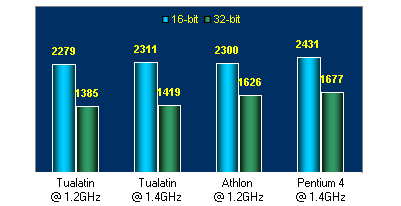HardwareZone heeft een korte review on-line gezet van de Pentium III op 1,2GHz met de nieuwe Tualatin core. De geteste desktop verie heeft, evenals de Coppermine core, 32KB L1 cache en 256KB L2 cache. Het exemplaar is vrij gemakkelijk met een FSB van 160MHz aan te sturen met als gevolg dat de CPU dan op 1,44GHz zijn werk doet. De vernieuwde Pentium III core zet klok voor klok nagenoeg dezelfde resultaten neer als een Thunderbird van AMD. Het benodigde vermogen is dankzij de 0,13 micron technologie verlaagd waardoor de koeler ook relatief klein kan blijven. Ook is het gebruik van een 250 Watt voeding normaal gesproken voldoende, de Tualatin heeft aan 20,6 Ampère genoeg tegenover 38 voor een gelijk geklokte Thunderbird. De benchmarks geven nogmaals aan dat de Pentium 4 moeite heeft om de Tualatin processor voor te blijven, ook al is de laatste uitgerust met RDRAM:
The new Intel Tualatin is certainly going to be an interesting extension to Intel's Pentium III line of processors. With performance matching the Athlon, the Tualatin could very well give users a good alternative to using AMD's power hungry Athlon processor. With very low requirements for power (you can still use your old 250W ATX power supply unit) and low heat dissipation (a simple cooler should do the trick), the Tualatin is made for consumers seeking a quick and simple upgrade solution. The drawback is that users are required to change their current motherboard to accomodate the new Tualatin.The Pentium III has been around for quite a long time, and with the Tualatin, you can be sure of better and more stable performance using a well accepted processor core. The Tualatin is currently not available and we have not received any information pertaining to its launch in Singapore. However, judging from the price of current 1GHz Pentium III processors, we would expect the Tualatin to cost a lot more than the Athlon. If the price of Tualatin could match the Athlon, the new Tualatin could very well give upgraders the reason to move away from the Athlon. But for now, we can only cross our fingers and hope that Intel would do the right thing.

